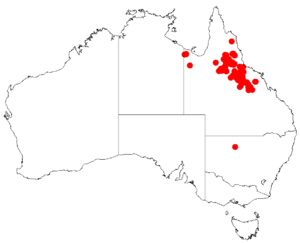Acacia lazaridis facts for kids
Quick facts for kids Acacia lazaridis |
|
|---|---|
| Scientific classification | |
| Genus: |
Acacia
|
| Species: |
lazaridis
|
 |
|
| Occurrence data from AVH | |
Acacia lazaridis is a type of shrub that belongs to the Acacia plant family, also known as wattles. This plant is native to the northeastern parts of Australia.
About Acacia lazaridis
This shrub usually grows to be about 0.5 to 2.5 meters (about 1.5 to 8 feet) tall. It is a very smooth plant, meaning it has no hairs on its surface. Its young branches are flat or angular and have a maroon-brown color. As they get older, they turn grey and have clear ridges, often covered with a white, powdery coating.
Like many Acacia species, Acacia lazaridis does not have true leaves. Instead, it has special structures called phyllodes. These phyllodes are tough, stiff, and green. They are long and narrow, sometimes slightly egg-shaped, measuring about 3 to 6.5 centimeters (1.2 to 2.5 inches) long and 7 to 30 millimeters (0.3 to 1.2 inches) wide. You can see three main lines, or nerves, running along them. This plant produces beautiful golden flowers, usually blooming between February and November.
Where Acacia lazaridis Grows
Acacia lazaridis is a plant that is endemic to Australia, which means it is found naturally only in a specific area and nowhere else in the world. You can find it in the western parts of the Kennedy and Cook Districts in Queensland.
It often grows on the lower slopes of the Great Dividing Range. You'll typically see it on ridges, hillsides, or hilltops. It prefers to grow in red, gravelly soils or shallow sandy soils that are on top of sandstone or granite rock. This shrub is usually found growing as part of Eucalyptus forests or woodlands, or in scrubland alongside other Acacia plants and species of Triodia (spinifex grasses).

